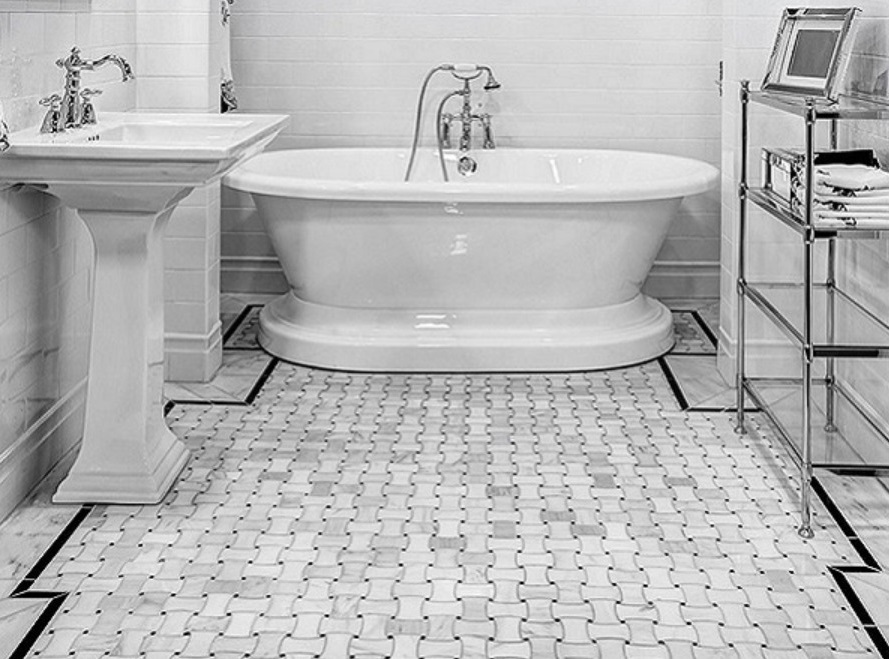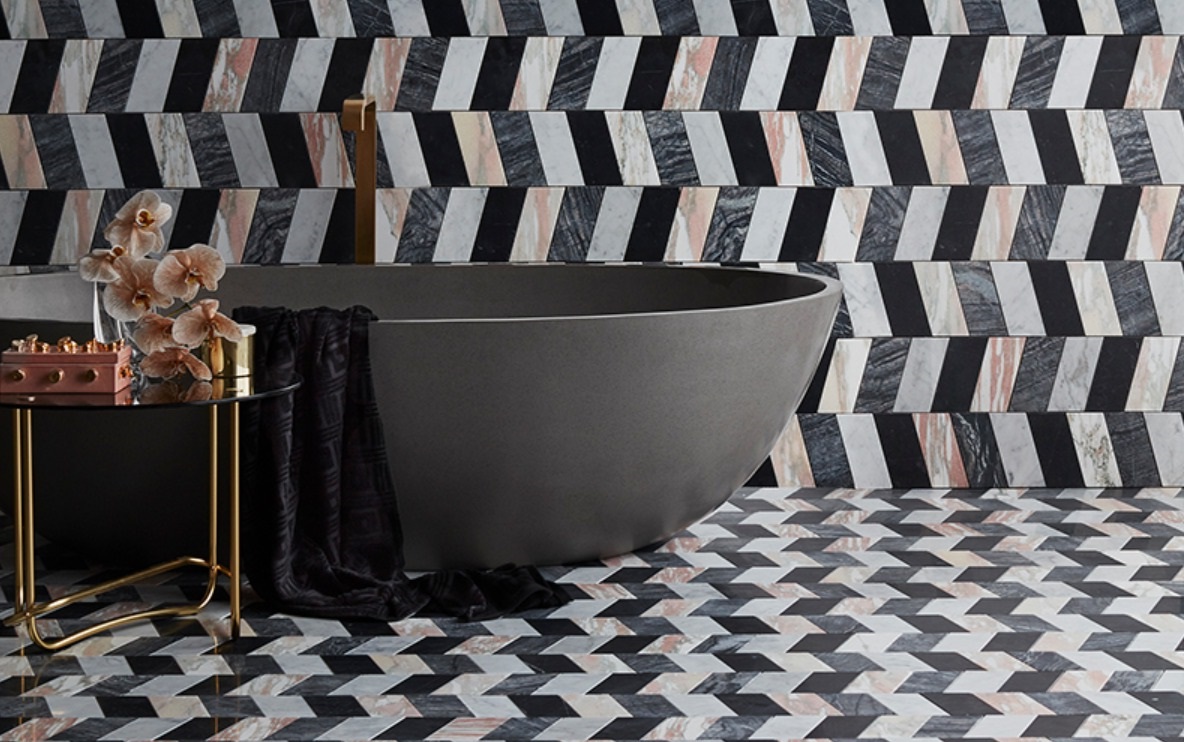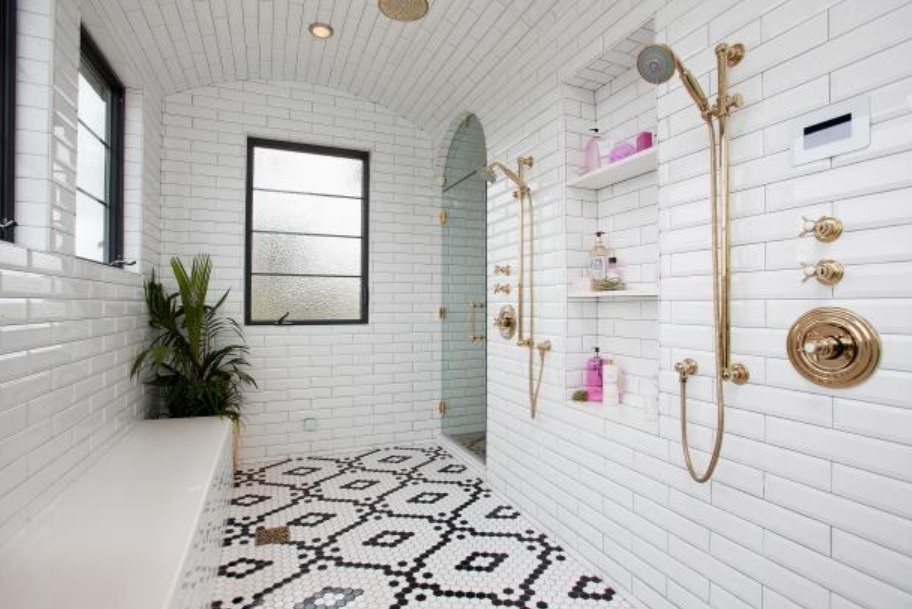If you want to apply the mosaic bathroom floor tile, it is better to read our article today for further consideration. We are going to provide you with the advantages and disadvantages of mosaic glass tile.

The Advantages
Easy to clean
Glass tiles are resistant to mildew, mold, and stain. They usually can show dirt so easily that will notice you the time to clean them. They are not porous and resistant to chemical damage, so you don’t need to be afraid about grime sinking into your bathroom’s tile. Since they are easy to wipe, you will have an easier job to clean them with only mopped up or a damp cloth with warm water. You can also use a mild vinegar solution for soap-scum buildup on your bathroom’s floor.
Beautiful design
It might be the largest advantage of using mosaic glass in a flooring application is the elegance that can be seen with the right installation. There are two options available for you to choose between multicolored or solid tiles that can be designed in simple or complicated patterns. There are also repeating patterns you can find in the store that can be used to make complex designs and pictures.
Durability
Mosaic glass tile should be resistant and durable to cracking as long as they have passed the standard of stringent ASTM required to be accepted for use as the material of flooring. They shouldn’t crack under something less sharp direct force which is applied with a sturdy object like a hammer. Meanwhile, glass tiles are prone to scratch.
Luminous appearance
Darkest glasses tiles usually will reflect light instead of absorbing it. So, it makes this type of glass tile can make the mosaic pattern look glowing with a luminous appearance which you can’t find in any other materials for flooring.

The Disadvantages
Hard installation
Unlike natural stone tiles or ceramic, glass mosaics are usually hard to install. The adhesive will show through the tile if you are careless. Unless you are not a professional in laying tile, it is better to ask for help from an expert who can do the job perfectly. Even though you will spend more money on hiring one, at least the result will satisfy you.
Expensive cost
One of the biggest disadvantages of using mosaic glass tiles is the cost. It can be around $35 a square foot for the good colors. If you want repeating patterns, they are around $110 for a single square foot.
So, do you still stick with the mosaic bathroom floor tile after knowing the advantages and disadvantages? With proper installation and enough budget, we still think that mosaic glass tiles can make a dreamy bathroom you’ve always wanted.
Is Mosaic Tile Suitable for Bathroom Floors?
Mosaic tiles have been a popular choice in architecture and design, adorning homes and architectural marvels throughout history. They offer a strong and decorative option for the home. However, are mosaic tiles the right choice for bathroom flooring?
What are Mosaic Tiles?
Mosaic tiles are a small format tiling solution available in various shapes and sizes, with the classic square mosaic tile being the most common. Due to their small size, they are usually sold in sheet form, where each tile is mounted on a mesh sheet backing in different sizes, often around 30 x 30 cm with variations in sheet size due to the different shapes of these tiles.
Using mosaic tiles in sheet format allows for easy installation in the home, simplifying the process compared to ancient buildings that used artisanal mosaic tiles where each piece was made and laid by hand.
Is Mosaic Tile Suitable for Bathroom Floors?
Mosaic tiles are traditionally used in public swimming pools and changing areas for a reason; they are very durable, hygienic and provide an excellent solution for wet areas. When considering mosaic tiles for bathroom flooring, it’s essential to think about the texture and material as some options are not suitable for flooring while others are. Generally, natural stone mosaic tiles and most glass mosaic tiles can serve as bathroom flooring options. However, it’s important to always seek advice from an expert to ensure your choice best suits your bathroom design scheme.
Cleaning Mosaic Tiles
The most common concern with using mosaic tiles for the bathroom is cleaning the grout lines between each tile. For most glass mosaic tiles, an epoxy grout solution is often recommended instead of traditional cement-based grout options, while natural stone tiles are better suited for a sealed cement-based option that is properly maintained.
Epoxy grout is a non-porous option that will not stain or discolor and will help prevent the build-up of grime and dirt in your bathroom floor tile’s grout lines. It’s important to note that harsh cleaning products such as bleach, for example, should not be used to clean epoxy grout, as they can cause discoloration. In general, a quality epoxy grout should only require a simple solution of warm soapy water to keep clean, similar to glass mosaic tiles as well.
If you’ve been considering whether mosaic tiles are a good choice for the bathroom floor, there are numerous exciting options available to help you create the perfect bathroom design scheme! These versatile options can be utilized to create a wonderfully tactile flooring option in the bathroom that is full of color, texture and energy!
Using mosaic tiles in the bathroom offers several advantages.
Tile is a crucial part of almost every bathroom design. Tile is versatile, water resistant, and can be installed on the floor, walls, or ceiling. Mosaic tiles in particular have all of these same benefits and attributes but can offer even more with added function and style when utilized in the bathroom.

What are Mosaic Tiles?
Mosaic tiles are described as any material, type, or shape of tile that measures 2 inches or smaller. Mosaic tiles are typically affixed to sheets of either mesh or contact paper, making them easier to install. Most mosaic tiles can be installed in approximately 12-inch increments. The sheets can be easily cut between the rows of mosaic, enabling the tiles to be used in smaller areas, such as single-row borders.
Due to their size, mosaic tiles can accomplish things that larger tiles cannot, providing a variety of benefits and uses that can truly enhance your bathroom design. Explore the following benefits of using mosaic tile in the bathroom to elevate your design to the next level.
What are the advantages of using Mosaic Tiles in the bathroom?
- Enhanced Safety for Your Floor
An excellent feature of mosaic tiles in the bathroom is their capacity to create a surface that reduces the risk of slipping. When mosaic tiles are installed, they use more grout compared to larger tiles, which enhances slip protection. If the mosaics are textured, this further improves the slip resistance.
With the growing adoption of universal design in homes, using mosaic tiles on the bathroom floor not only increases slip protection but also makes the space more functional and user-friendly for a wide range of users, including the elderly, young children, and people with disabilities. Even if you don’t want to cover the entire floor with mosaics, you can still benefit by using them in specific areas like the shower floor or as a tile “rug” in front of the tub or sink – areas that are more prone to being wet and pose a higher risk of falls.
- Efficient Water Drainage
Mosaic tiles are helpful in facilitating the required slope for efficient water drainage, whether it’s for a separate shower or for creating a wet room where the entire bathroom floor needs to slope toward the drain. For a shower, the floor needs to slope ¼-inch for every foot toward the drain. In the case of a European-style wet room, the entire bathroom floor needs to slope 1.5 to 2 degrees toward the drain. Mosaic tiles are flexible enough to conform to these slopes, unlike larger tiles which are prone to cracking over time.
- Compliance with ADA Guidelines
Accessible Design is on the rise, and using mosaic tiles in the bathroom can contribute to meeting ADA guidelines for accessible design. This includes features such as a barrier-free shower, where the bathroom floor seamlessly transitions into the shower floor without a threshold. Mosaic tiles not only meet this requirement but also provide slip protection and better grip for wheelchair users, as well as a texture difference for visually impaired individuals. Therefore, mosaic tiles are recommended for ADA compliant and Accessible bathroom designs.
- Definition of Space
Apart from the functional benefits, mosaic tiles also offer design and style advantages for the bathroom. They can be used to define spaces by creating mosaic “rugs,” using mosaic borders to distinguish different areas, or establishing a transition to a barrier-free shower floor.
Mosaic sheets can be easily cut into strips, allowing for the creation of borders or accents in various parts of the bathroom, such as beneath a chair rail or around a mirror. The individual small tiles in mosaics have a greater visual impact, especially when polished or glossy, making it easier to define areas. The change in texture compared to larger tiles also helps visually impaired individuals to identify different areas in the room.
- Using Decorative Accents is Simple
Mosaics are available in a wide variety of patterns, materials, sizes, and shapes. Ready-made mosaic borders with predetermined patterns are available, as well as mosaic field tiles that can be cut into strips for border applications. Moreover, companies specializing in mosaic design can create complete murals, pictures, and scenes using mosaic tiles. This versatility makes mosaics an ideal choice for adding accents and visual design elements to a bathroom.
Use mosaics to distinguish between two areas, line the back of a shower wall niche with a single sheet of mosaic to make it stand out, or cut a single sheet of mosaic tiles into multiple strips for an effortless accent anywhere in the room. With this level of flexibility, mosaics can be used to create an extensive range of styles, from retro bathrooms with patterned mosaic floors to contemporary spaces that utilize glass mosaics to introduce color.
- Captivating Focal Points
Mosaics can create captivating focal points in a bathroom in various ways. They can be used to craft a mural for either the floor or wall. They can also serve as a type of “tile wallpaper” to introduce patterns to the space.
Even plain mosaics in materials like glass, polished marble, or another visually striking material can be used to line the back of a single wall in the shower to draw attention to that area. The way mosaics individually catch the light adds an additional element of interest to a design, instantly capturing one’s attention. If you want to draw attention to a specific area of the room or visually manipulate the room by directing focus to specific areas, mosaics can help achieve these objectives more effectively than certain other materials. Moreover, mosaics tend to stand out more than larger tiles of the same material or color, making them more likely to capture the viewer’s attention.
- Creating the Illusion of More Space
Designing a small bathroom involves following various guidelines. Many homeowners try to find ways to visually expand a small room, which mosaics can aid in achieving.
While one approach to visually enlarging a small space involves using large or oversized floor tiles to minimize grout lines and create a more streamlined appearance, mosaic tiles can also achieve the same effect. Despite the numerous grout lines, mosaic tiles do not create a grid effect on the floor, which is a limitation of medium-sized tiles in a small space, as the grid breaks up the floor and makes it appear smaller. Instead, mosaics create an overall pattern on the floor, leading to the room appearing larger; the grout becomes part of the pattern rather than an element that disrupts the space. Whether you select a classic basket weave or penny tile pattern, a solid field tile, or a custom pattern for the bathroom floor, mosaic tiles can visually enlarge the space.
